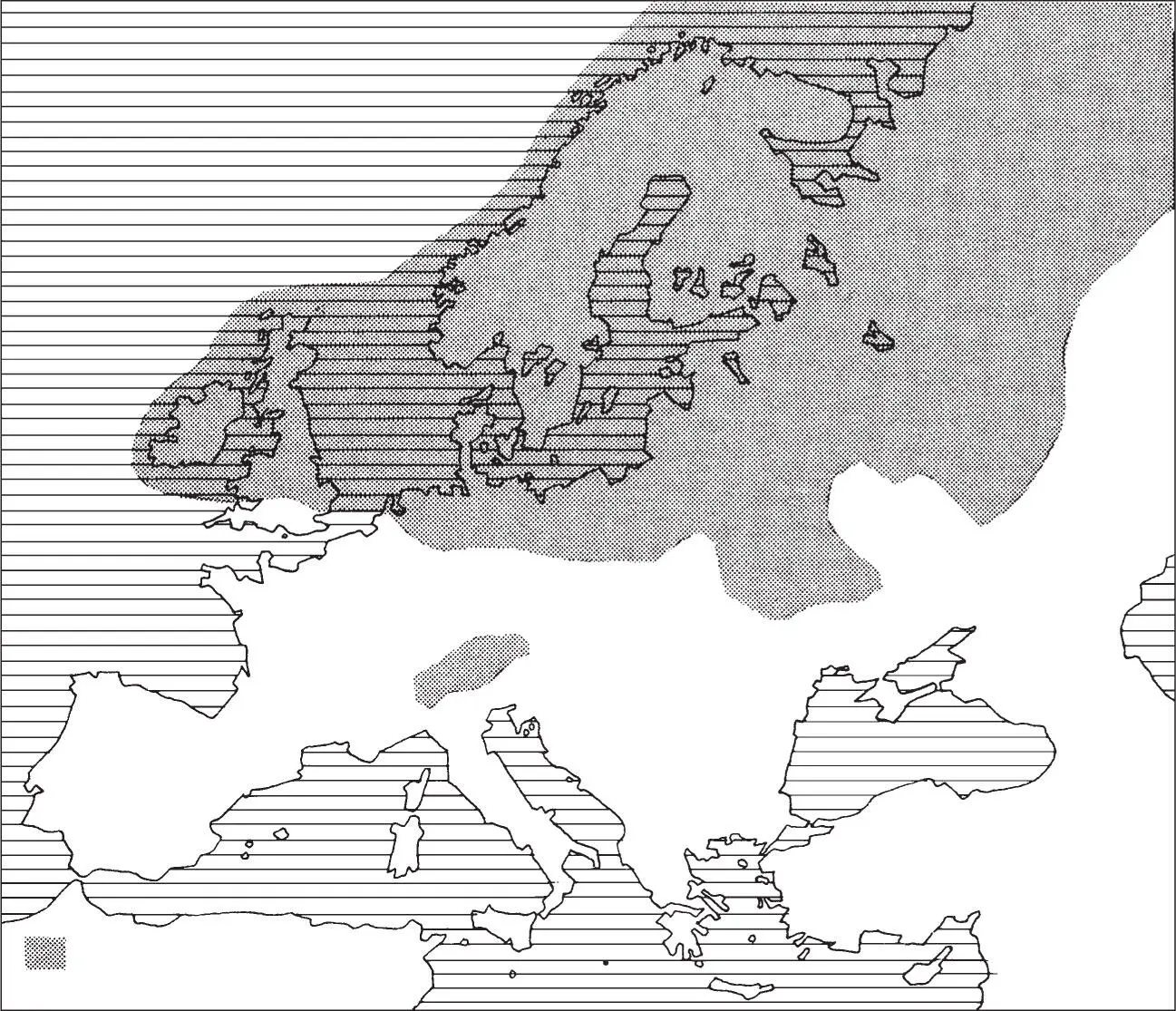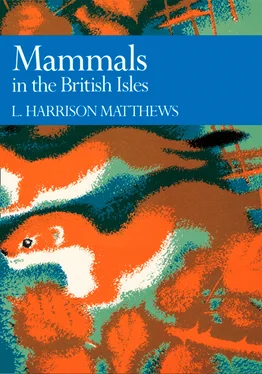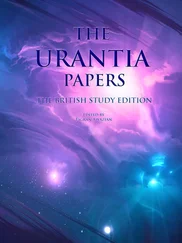In the chapters that follow we consider the biology of this mammalian fauna, enquire into its origin and present distribution, and investigate the way of life of its various members, and how it shares the approximately 75 million acres of its homeland with over fifty million human beings.
CHAPTER 2
ICE AGES
THE small number of mammalian species now living in the British Isles is sometimes spoken of as an impoverished fauna. This is not strictly correct; it is a small fauna compared with those of some other lands, but of the forty-six indigenous species only five have been exterminated in historic times, whereas fourteen that are not indigenous have been introduced and now permanently enrich it. The causes of the present composition and distribution of our indigenous mammalian fauna must be sought in the geological history of the islands.
The basic geological structure of the country has evolved through enormous periods of time during which the rocks were laid down as deposits on the floors of successive seas, or extruded through the earth’s crust by volcanic activity. If we could see from a satellite the events forming the present topography of the earth as in a time-lapse film, so that many millions of years were concentrated into an hour, the tortured crust would appear to be in constant movement, writhing and squirming as immense forces distorted it. The tectonic plates jostling each other or drawing apart to form the oceans, pushed asunder by the material rising between them from below, were sometimes sunk far beneath the sea from which they received deposits of enormous thickness, or thrust up into mountains and lands from which erosion carried their substance back to the oceans – everything was, and still is, in constant flux. During all these upheavals plants and animals were evolving ever since life first appeared on the earth some time in the Precambrian epoch, perhaps as much as three thousand million years ago.
The successive epochs into which palaeontologists divide geological history each had their characteristic faunas and floras which left their remains as fossils in the rocks, representing a biomass, or aggregate of living matter, so great that it is almost beyond comprehension to the human mind. Among this teeming swarm the mammal-like creatures first appeared in the Triassic epoch, which began some 225 million years ago; but ten million years were to pass before the Eutheria, the placental mammals, evolved towards the end of the Cretaceous epoch. In the succeeding Eocene epoch, which began about seventy million years ago, the orders of mammals that we know as living animals were already differentiated together with others that are now extinct.
During the following epochs, the Oligocene and the Miocene, in which great crustal disturbance took place, including the upraising of the great mountain ranges, the evolution of the mammals produced a vast variety of forms which reached a peak in numbers before the end of the Miocene some twelve million years ago. In the succeeding Pliocene, which lasted about ten million years, the land masses gradually took on their present shapes, and mammalian species began to decline in number, a decline that continues to the present day. Throughout these epochs the climate varied from time to time, sometimes temperate, at others cool and wet, or warm and arid, but it was not until the Pleistocene that the greatest climatic change in later geological history took place.
The Pleistocene epoch was comparatively short; it has been deeply studied using modern techniques during the last fifty years so that our knowledge of it increases every day. It was formerly thought to have lasted about a million years, but is now known to have been probably twice as long – some authorities consider it to have lasted as much as three million years. It is popularly called the ‘Ice Age’, a name that over-simplifies the matter, for the ice ebbed and flowed so that mild periods of sometimes almost tropical warmth, separated successive glaciations. At its height ice sheets covered most of Europe, North America and northern Asia, while another covered Antarctica, as it still does.
It was in 1837 that Louis Agassiz, the Swiss and later American geologist and zoologist, first drew attention to the evidence that glaciers had once covered much of the land, evidence which he had discovered in 1836 on his field excursions in search of fossil fishes. 4His views were adopted by the Reverend Dr William Buckland F.R.S., Canon of Christ Church and Professor of Geology at Oxford, later Dean of Westminster, the English pioneer geologist and palaeontologist. He found similar evidence in the British Isles, especially the grooves and scratches scored in rock surfaces of the north, over which glacial ice had flowed engraving the substrate with the burins of its entrapped stones. 28
Buckland was the first President of the British Association for the Advancement of Science, and when he addressed the ‘British Ass’ on the subject of glaciation one of his waggish friends drew a caricature of the great man standing on a surface covered with glacial scoriations while at his feet lay two pebbles, one of them labelled ‘specimen no. 1, scratched by a glacier thirty-three thousand three hundred and thirty-three years before the creation’; the other, ‘no. 2, scratched by a cart wheel on Waterloo bridge the day before yesterday.’

Fig. 2. Position of the ice edge at maximum cover of Eurasian glaciation during the Anglian glaciation of the British Isles.
As with all new theories before they become accepted as established truth, the glacial theory at first met with much opposition as well as ridicule – indeed Buckland himself at first strongly disagreed, and it was only during a tour of Scotland in company with Agassiz in 1840 that he was convinced. Thereafter he has strongly supported the theory and, through the evidence of glacial action on polished and scoriated rocks and the presence of morraines, most of the leading geologists of the day agreed with him. He was also the first to suggest that the famous parallel roads of Glenroy in Scotland were the former shore lines of a glacial lake formed by the damming of Glen Spean by two glaciers coming down the north and east sides of Ben Nevis.
The knowledge that the country, and later that all countries on both sides of the north Atlantic, had once been in the grip of an Ice Age stimulated geologists to more detailed research, and it soon became apparent that there had been not one Ice Age but several. The difficulties of identifying and dating them were enormous, because younger glaciations are bound to disturb, distort, and confuse the traces of older ones, as are denudation, erosion, and changes of sea level in the often long intervals between them. Local variations in the extent and intensity of glaciation further complicate the problem.
The basic pattern of the successive glaciations in Europe was appropriately worked out by investigating the glaciations of the Alps, where Agassiz had first discovered evidence of the ‘Ice Age’. About the beginning of this century Penck & Brückner 122, after prolonged study of the gravel terraces laid down by rivers rushing forth from beneath the melting glaciers, concluded that there had been four main ice ages separated by long interglacial periods when the land was free from ice-cover and the climate was comparatively warm. They named the four glaciations after rivers flowing down from the Austrian alps to southern Germany, in the valleys of which they examined the fluvioglacial gravels and moraines; the oldest they named Günz, and the succeeding ones Mindel, Riss and Würm.
Читать дальше













